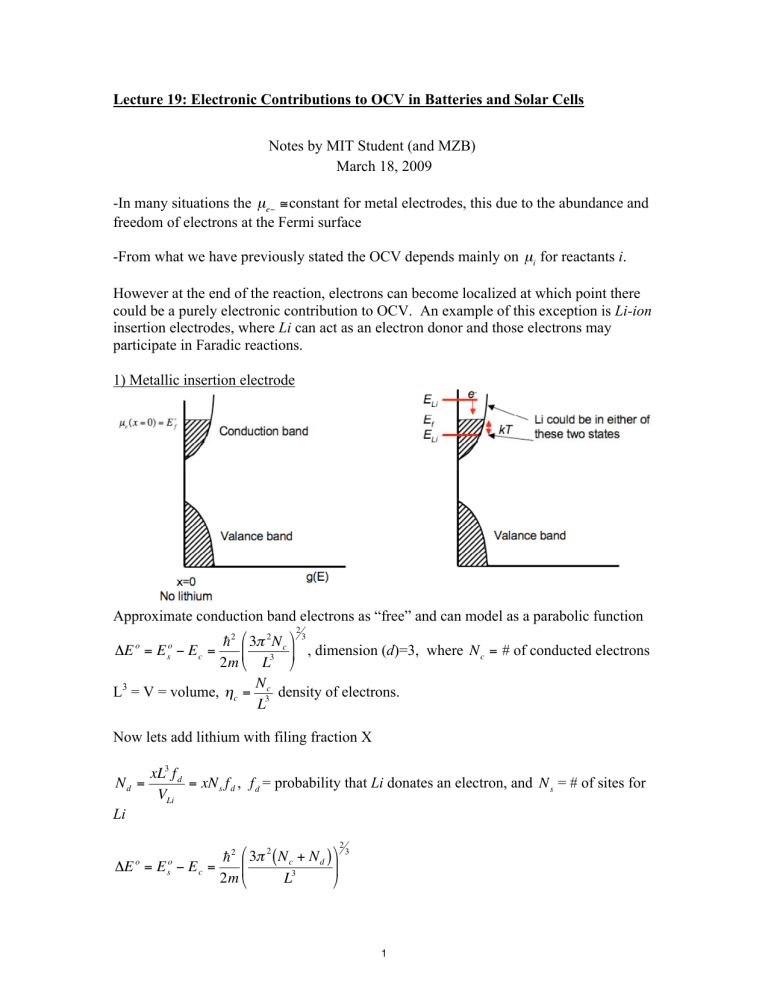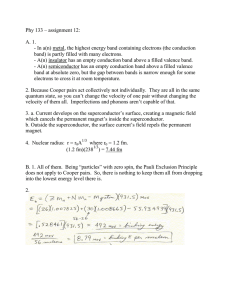Document 13488526

Lecture 19: Electronic Contributions to OCV in Batteries and Solar Cells
Notes by MIT Student (and MZB)
March 18, 2009
-In many situations the µ e −
≅ constant for metal electrodes, this due to the abundance and freedom of electrons at the Fermi surface
-From what we have previously stated the OCV depends mainly on µ i
€
for reactants i .
However at the end of the reaction, electrons can become localized at which point there could be a purely electronic contribution to OCV. An example of this exception is Li-ion insertion electrodes, where Li can act as an electron donor and those electrons may participate in Faradic reactions.
1) Metallic insertion electrode
€
€
Approximate conduction band electrons as “free” and can model as a parabolic function
Δ E o
= E s o
− E c
=
2
2 m
3 π
L
2
3
N c
2
3
, dimension ( d )=3, where N c
= # of conducted electrons
L 3 = V = volume, η c
=
N c density of electrons.
L 3
€
Now lets add lithium with filing fraction X
N d
= xL
V
€
Li f d = xN s f d
, f d
= probability that Li donates an electron, and N
Li s
= # of sites for
Δ E o
= E s o
€
− E c
2
=
2 m
3 π
2 ( N c
L
3
+ N d
)
2
3
€
€
1
€
€
€
€
€
€
€
€
€
= Δ E o
f
1 +
N d
N c
2 d
= Δ E o f
1 + xf d
V
Li
η c
2 d where V
Li
η c
= the number of conduction electrons per Li cell or site also, note that the conduction band is confined to d dimensions 1 ≤ d ≤ 3
Δ ( ) = Δ E o f
1 + xf
V
Li d
η c
2 d
€ where α = f d
V
Li
η c
=
# of
# of donated Li electrons conduction
€ electrons per for a good conductor and large Li unit cell => α << 1 therefore, site
=
( ) ~ Δ E f o
+
2 d
α x + ...
# of donated e −
# of conduction e −
Δ µ e
−
( ) = Δ ( ) − Δ E ( ) = Δ E o f
( 1 + α x )
2 d − 1
α << 1 ~ Δ E o f
2 α x d
V o
( ) = V o
−
µ
Li
( ) + e
µ e
−
= V o
−
µ
Li e
−
2 α de x
€
2
€
2) Semiconducting Insertion Electrodes
Note for insulators: for insulators where energy gap is very large and α = 0 , because
δ d ≅ 0 , Li cannot liberate electrons.
€
€
€
€
€
€ f
N d
L
≠ 0
= 0
Δ
Δ
E
(
=
E x
2
=
2 m
0 )
3
=
π
0
L
2
N
3 d
2
3
Δ µ e
( ) = Δ ( ) = ( const )( f d x )
2 d
3
3) Solar Cells drops in energy goes into phonons
(vibrations) and is lost, if you can find ways to harvest all the energy and not lose it yield large improvements
Light quanta (photons) with energy larger than the band gap can be absorbed as
“excitons” or electron-hole pairs. The absorbed photon energy can be lost by radiative recombination (the reverse process of adsorption, where the electron and hole recombine and release a photon) or by non-radiative processes, such as scattering interacting with the crystal atoms, which transmits energy to quantized lattice vibrations (phonons). Since there are many available electron states in the conduction band and hole states in the valence band, non-radiative processes tend to occur very quickly and cause the exciton’s energy to settle down to the band gap, with the electron at the lower conduction band edge and the hole at the upper valence band edge.
A photovoltaic cell is designed to extract the energy of the exciton as electrical energy in the external circuit, by collecting electrons at the cathode and holes at the anode. The open circuit voltage of the cell is the mean exciton energy, which is close to the band gap of the semiconductor due to non-radiative processes.
With these concepts, we are ready to calculate the “ultimate efficiency” of a solar cell
(Shockley, Quiesser 1961), based on the principle of detailed balance:
-Every photon striking the solar cell w/ E p
> E g
yields an exciton at the gap E = E g that is harvested as open circuit voltage, without any other energy losses.
€ €
4
€
€
η =
Power out
=
Power in
E g
∫
∞
∫
∞
E g
( ) dE
EN s
( ) dE o
N s
( ) = density of photon energy. The solar spectrum is well approximated by a black body at temperature T sun
= 6000K, where N(E) is given by Planck’s formula
η =
~
E g
∫
~
∞
E g
e x x 2
− 1
dx
∞
∫
dx o
x
e − x
3
− 1
€
€
An amazing and fortunate fact: At room temperature, kT =25mV is much smaller than typical energies of chemical bonds in materials, which are at the scale of Volts. However, the temperature of the sun at 6000K is such that kT=0.5V
~
E g
~
E g
= =
E g
0.5
V kT s and thus the maximum in the SQ formula for ultimate efficiency is comparable to actual bandgaps in readily available materials, so that efficient solar cells can be constructed on
~ earth. In particular, the SQ maximum efficiency of 44% occurs at E max eff g
≅ 1.1
Volts, which happens to be close to band gap energy of silicon, an abundant element, making it an ideal solar cell material.
€
5
There are several ways to design solar cells to harvest photo-induced excitons. In traditional silicon solar cells, the exciton is generated in a p-n junction between “p-type silicon” (doped with acceptor impurities which attract valence-band holes) and “n-type silicon” (doped with donor impurities which attract conduction-band electrons). The junction separates the electrons from the holes, which are collected at opposite electrodes.
In a dye-sensitized “Graetzel cell”, the cathode consists of a semiconducting anode (e.g.
TiO2) coated with a photo-sensitive dye (e.g. rutenium based). The dye adsorbs solar photons and transfers the electrons to the semiconductor electrode, while holes are removed by oxidation reactions with an electrolyte (e.g. iodide solution), which carries current to the cathode for reduction and completing the circuit.
6
MIT OpenCourseWare http://ocw.mit.edu
10.626
Electrochemical Energy Systems
Spring 20 14
For information about citing these materials or our Terms of Use, visit: http://ocw.mit.edu/terms .


